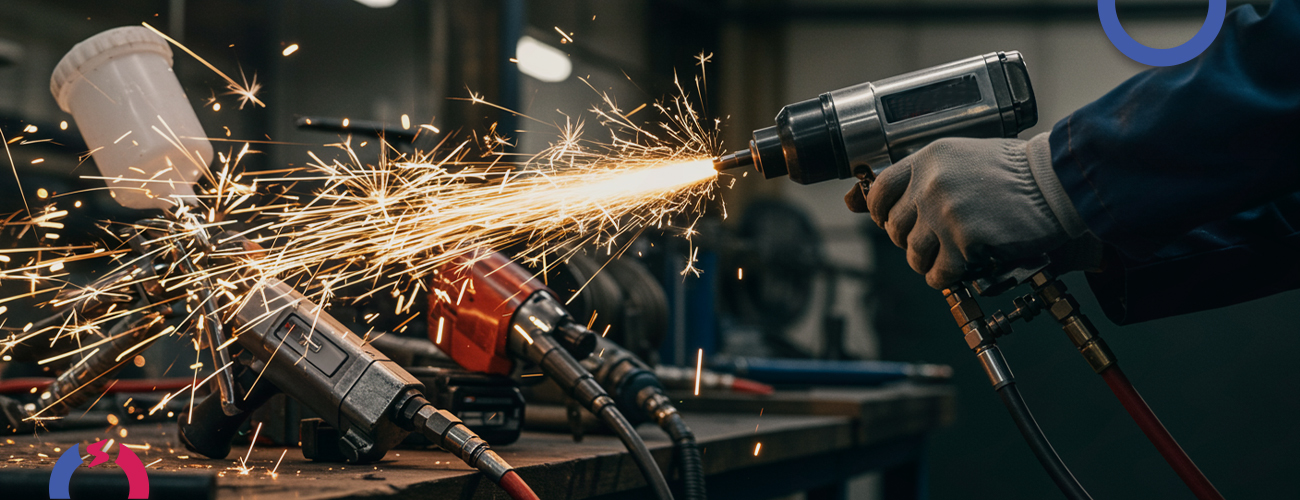Air tools are an essential part of modern industrial and construction work. These tools, powered by compressed air, offer numerous advantages over traditional electric-powered tools, including lightweight design, high torque, and exceptional durability. Whether you’re a professional mechanic, contractor, or DIY enthusiast, understanding the different types of air tools and how to use them effectively can significantly enhance your productivity.
What Are Air Tools?
Air tools, also known as pneumatic tools, operate by using compressed air to generate mechanical motion. They include a wide range of tools such as air drills, air hammers, air ratchets, impact wrenches, and sanders. The main benefits of using air tools include their superior power-to-weight ratio, safety, and reliability. These tools are ideal for high-intensity work environments such as factories, construction sites, and automotive workshops.
Types of Air Tools:
-
Air Impact Wrenches: These tools are commonly used in automotive and construction industries. They provide high torque with minimal effort, making them perfect for tasks like tightening bolts and removing stubborn fasteners.
-
Air Drills: Air drills are more lightweight than electric drills, making them easier to handle for extended periods. They are also highly effective when working in tight spaces, making them an excellent choice for intricate tasks.
-
Air Sanders: Air sanders are used for smoothing surfaces and finishing work. These tools provide excellent precision, allowing for detailed sanding of wood, metal, or plastic surfaces.
-
Air Hammers and Chisels: These tools are often used in demolition work, capable of breaking through concrete, stone, and other hard materials.
-
Air Ratchets: These are useful for tightening or loosening fasteners in hard-to-reach places, such as under the hood of a car or in machinery.
Advantages of Air Tools:
-
Lightweight and Comfortable: Unlike electric tools, air tools tend to be lighter, reducing user fatigue and improving comfort during long hours of use.
-
Safety: Since air tools do not rely on electricity, they pose less of a fire hazard in environments where sparks can be dangerous, such as in flammable environments.
-
Durability: Air tools are known for their durability and long life. With minimal moving parts, they are less prone to wear and tear.
-
Cost-Effective: Though air tools often require an air compressor for operation, they are relatively inexpensive to maintain and can be more cost-effective in the long run compared to electric tools.
How to Choose the Right Air Tools:
When selecting air tools, it’s essential to consider the following factors:
-
Power Requirements: Different tools require different amounts of compressed air. Be sure to check the specifications of the tool and your air compressor’s output.
-
Weight and Size: Choose a tool that fits comfortably in your hand and isn’t too heavy for extended use.
-
Ergonomics: Look for tools that are ergonomically designed to reduce fatigue and improve user comfort.
-
Brand and Warranty: Opt for reputable brands that offer warranties and support in case of tool failure.
Maintenance Tips for Air Tools:
To ensure that your air tools last a long time and function efficiently, regular maintenance is necessary:
-
Lubricate Regularly: Air tools should be lubricated regularly to reduce friction and prevent parts from wearing out too quickly.
-
Keep Air Filters Clean: Clogged air filters can reduce tool efficiency and even cause the tool to malfunction. Clean the filters frequently to ensure optimal performance.
-
Check for Leaks: Air leaks can waste a significant amount of energy. Regularly check the air hose and tool connections for any signs of leaks.
-
Proper Storage: When not in use, store air tools in a dry and clean environment. This helps protect them from rust and damage.
Conclusion:
Air tools have transformed industries worldwide, from construction to automotive repair. Their lightweight design, durability, and power make them an excellent choice for professionals and hobbyists alike. By choosing the right air tools for your needs and maintaining them properly, you can ensure optimal performance and longevity.


